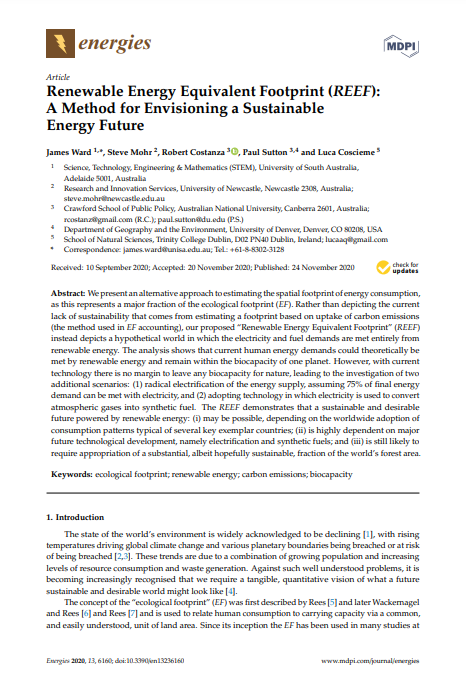
Hot or Cool Institute is a public interest think tank that explores the intersection between society and sustainability, we bring together researchers and practitioners to facilitate solutions to global problems.

We present an alternative approach to estimating the spatial footprint of energy consumption, as this represents a major fraction of the ecological footprint (EF). Rather than depicting the current lack of sustainability that comes from estimating a footprint based on uptake of carbon emissions (the method used in EF accounting), our proposed “Renewable Energy Equivalent Footprint” (REEF) instead depicts a hypothetical world in which the electricity and fuel demands are met entirely from renewable energy. The analysis shows that current human energy demands could theoretically be met by renewable energy and remain within the biocapacity of one planet. However, with current technology there is no margin to leave any biocapacity for nature, leading to the investigation of two additional scenarios: (1) radical electrification of the energy supply, assuming 75% of final energy demand can be met with electricity, and (2) adopting technology in which electricity is used to convert atmospheric gases into synthetic fuel. The REEF demonstrates that a sustainable and desirable future powered by renewable energy: (i) may be possible, depending on the worldwide adoption of consumption patterns typical of several key exemplar countries; (ii) is highly dependent on major future technological development, namely electrification and synthetic fuels; and (iii) is still likely to require appropriation of a substantial, albeit hopefully sustainable, fraction of the world’s forest area.

Hot or Cool Institute is a public interest think tank that explores the intersection between society and sustainability, we bring together researchers and practitioners to facilitate solutions to global problems.
© Hot or Cool Institute gGmbH | All rights reserved
Don’t miss out on news from the Hot or Cool Institute. Subscribe to receive updates on research, projects, and more.



